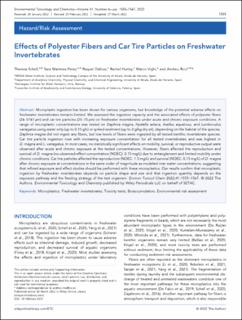| dc.contributor.author | Schell, Theresa | |
| dc.contributor.author | Martinez-Perez, Sara | |
| dc.contributor.author | Dafouz, Raquel | |
| dc.contributor.author | Hurley, Rachel | |
| dc.contributor.author | Vighi, Marco | |
| dc.contributor.author | Rico, Andreu | |
| dc.date.accessioned | 2022-07-12T11:06:59Z | |
| dc.date.available | 2022-07-12T11:06:59Z | |
| dc.date.created | 2022-05-05T09:38:08Z | |
| dc.date.issued | 2022 | |
| dc.identifier.citation | Environmental Toxicology and Chemistry. 2022, 41 (6), 1555-1567. | en_US |
| dc.identifier.issn | 0730-7268 | |
| dc.identifier.uri | https://hdl.handle.net/11250/3004659 | |
| dc.description.abstract | Microplastic ingestion has been shown for various organisms, but knowledge of the potential adverse effects on freshwater invertebrates remains limited. We assessed the ingestion capacity and the associated effects of polyester fibers (26–5761 µm) and car tire particles (25–75 µm) on freshwater invertebrates under acute and chronic exposure conditions. A range of microplastic concentrations was tested on Daphnia magna, Hyalella azteca, Asellus aquaticus, and Lumbriculus variegatus using water only (up to 0.15 g/L) or spiked sediment (up to 2 g/kg dry wt), depending on the habitat of the species. Daphnia magna did not ingest any fibers, but low levels of fibers were ingested by all tested benthic invertebrate species. Car tire particle ingestion rose with increasing exposure concentration for all tested invertebrates and was highest in D. magna and L. variegatus. In most cases, no statistically significant effects on mobility, survival, or reproductive output were observed after acute and chronic exposure at the tested concentrations. However, fibers affected the reproduction and survival of D. magna (no-observed-effect concentration [NOEC]: 0.15 mg/L) due to entanglement and limited mobility under chronic conditions. Car tire particles affected the reproduction (NOEC: 1.5 mg/L) and survival (NOEC: 0.15 mg/L) of D. magna after chronic exposure at concentrations in the same order of magnitude as modeled river water concentrations, suggesting that refined exposure and effect studies should be performed with these microplastics. Our results confirm that microplastic ingestion by freshwater invertebrates depends on particle shape and size and that ingestion quantity depends on the exposure pathway and the feeding strategy of the test organism. | en_US |
| dc.language.iso | eng | en_US |
| dc.publisher | Wiley | en_US |
| dc.rights | Navngivelse-Ikkekommersiell 4.0 Internasjonal | * |
| dc.rights.uri | http://creativecommons.org/licenses/by-nc/4.0/deed.no | * |
| dc.title | Effects of Polyester Fibers and Car Tire Particles on Freshwater Invertebrates | en_US |
| dc.type | Peer reviewed | en_US |
| dc.type | Journal article | en_US |
| dc.description.version | publishedVersion | en_US |
| dc.rights.holder | © 2022 The Authors | en_US |
| dc.source.pagenumber | 1555-1567 | en_US |
| dc.source.volume | 41 | en_US |
| dc.source.journal | Environmental Toxicology and Chemistry | en_US |
| dc.source.issue | 6 | en_US |
| dc.identifier.doi | 10.1002/etc.5337 | |
| dc.identifier.cristin | 2021651 | |
| cristin.ispublished | true | |
| cristin.fulltext | original | |
| cristin.qualitycode | 2 | |

